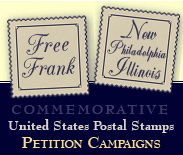Free Frank was the first African American to legally establish a town. In 1836, Free Frank legally established the town of New Philadelphia but Illinois state law precluded town incorporation by African Americans. New Philadelphia was located eighteen miles east of the Mississippi river in Pike County. Directly across was Mark Twain’s old town of Hannibal in the slave state of Missouri.
After 1835 Free Frank's land was purchased under the 1832 Land Act, made effective in the Illinois Military Tract when public land in this area was put on sale in 1834. While this act allowed a minimum purchase of forty-acre tracts, under the 1836 Land Act the federal government required full payment in specie for public land. Private land offices, quickly established in frontier areas, provided loans, but interest rates, which ran as high as 37 percent, discouraged some prospective buyers. Until the full amount was paid, the office controlled title to the land, and payment default often resulted in the farmer's loss of property and any improvements, as well. Table 6 shows a total of 800 acres in Hadley township purchased by Free Frank and his sons from 1830 through 1839. The location of each tract is shown in Figure 5, a federal surveyor's map of Hadley township.
By 1836, in addition to platting a town, Free Frank owned 600 acres of land. As a free black his right to the ownership of his property under Illinois law was somewhat limited. It was at best a specious right emanating from property rights granted blacks who had been indentured servants.31 But Free Frank's land purchasing activities in Kentucky and the court cases in which he had been involved in that state had demonstrated to him that in some instances American law could be used to the advantage of blacks. In 1836, using as a precedent the Illinois law that permitted manumitted blacks to own property, Free Frank petitioned the Illinois General Assembly for the right to take a legal surname so that title to his property would not be alienated. The surname requested in the petition was McWorter.32
A plat of New Philadelphia is shown in Figure 6. It was made in conformance to the Town Plat Act, which required that the "plat or map shall particularly describe and set forth all the streets, alleys, commons, or public grounds, and all in and out lots, or fractional lots, within, adjoining, or adjacent to said town, giving the names, widths, corners, boundaries, and extent of all such streets and alleys." Following the gridiron or checkerboard pattern characteristic of American towns, New Philadelphia was platted with 144 lots, each 60 by 120 feet.29 Main Street and Broad Way, the two principal streets, were 80 feet wide; the others were 60 feet wide, with alleys 19 feet wide. Although there is no indication of a town square on the plat, one was located at the intersection of Main Street and Broad Way. The names of the streets and alleys, their length and width, and the number and size of the lots were all determined by Free Frank, according to the Pike County surveyors, who entered the following statement in the plat book:
Sept. 16th 1836
I do certify that the foregoing is a true copy of the plat and survey of the Town of
Philadelphia Made by me by order of Free Frank the proprietor
P.JohnstonSPC Reuben Shipman chairmen Geane Joseph
Also In the 1820s, Free Frank and his wife Lucy were involved in two court cases in Kentucky and a legal arbitration hearing in Illinois in 1853, involving defense of their property. With Illinois only nominally a free state, New Philadelphia never became a haven or racial utopia, for blacks. New Philadelphia was at its height as a frontier town in the mid-1850s, with its various frontier town businesses and a population of 58, both blacks and whites. In 1869, the railroad bypassed the town. By 1870, the town was dead, leaving a farm population, primarily white, in the township.

